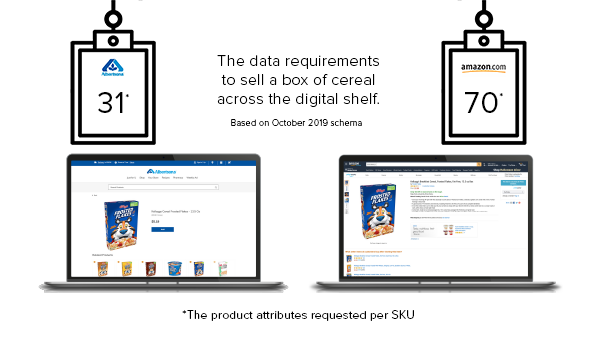Projections show the online grocery market in the U.S reaching $100 billion by 2022, according to 2019 research from the Food Marketing Institute (FMI) and Neilson. Grocery retailers are investing in digital shopping experiences to keep pace with these numbers while continuing to serve brick-and-mortar shoppers.
Albertsons Companies, one of the largest food and drug retailers in the U.S., is currently building on its strong local presence in 35 states by investing in micro-fulfillment centers. These centers will help the company meet the growing demand for online grocery delivery.
Online retail giant Amazon delivered tens of millions of grocery items at the end of 2019 through its subsidiaries Whole Foods Market and Amazon Fresh. The company had plans to expand its physical store footprint, focusing on convenience.
Grocery Brands Have the Power to Win on the Digital Shelf
The opportunity: Grocery brands can control precisely how products are displayed on the digital shelf — everywhere the products appear. Brands must deliver the right product information, images, and other digital assets in the right context to influence the next sale.
But delivering channel-specific content at the speed and scale required isn't easy.
Each retailer or distributor has different requirements and methods of data collection. These retailer requirements frequently change across product categories as retailers optimize and differentiate shopping experiences.
On Albertson's and Amazon, for example, item set up requirements for a box of cereal differ.

Syndication: The Right Content for the Right Place
At its simplest, syndication is about sending the right content to the right place. Sending data from Point A to Point B should be an open, transparent, and low-cost process.
Syndication can’t begin or end with mere data delivery to grow product sales. Brands need the ability to customize content for Amazon, Albertsons, and other essential channels while ensuring a consistent brand experience. They also need the ability to refine this experience to drive discovery.
This process requires an integrated system that lets brands store and manage channel-ready versions of product information. One that allows brands to adjust data for one channel — or across the core data set — dependent on need. One that will enable brands to validate data against these requirements so they can deliver the best content for every channel.
Written by: Cara Wood
Cara Wood (she/her) is a writer and former director of brand journalism at Salsify, where she specialized in creating content to help brands excel in ecommerce. Her work has helped organizations enhance their digital shelf and product experience management strategies.
Recent Posts
Prime Day Is Coming: A 5-Step Strategic Preparation Playbook for Brands
Artificial Intelligence for Ecommerce: A 7-Step Implementation Road Map for Leaders
Artificial Intelligence in Ecommerce: Real-World Examples of How AI Is Transforming the Industry
Subscribe to the Below the Fold Newsletter
Standing out on the digital shelf starts with access to the latest industry content. Subscribe to Below the Fold, our monthly content newsletter, and join other commerce leaders.


.svg)